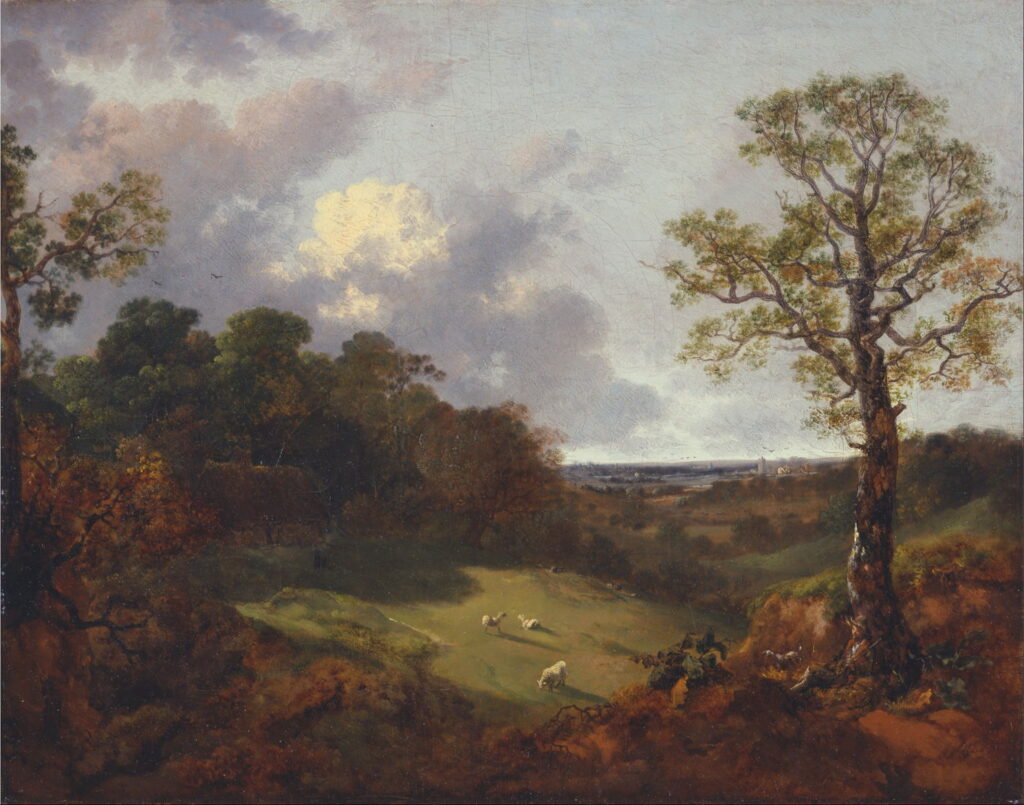A to Z of Landscapes: Trees 1

In every continent except Antarctica, the letter t in this alphabet of landscape painting can only stand for trees, whether in distant forests, framing the painting in repoussoir, or the subject of a portrait. Because of their frequency and importance, this week’s subject extends to two articles.
The depiction of trees has long been a popular subject for instructional texts about painting. Without exception, at least until the twentieth century, these have taught an anatomical method, where the structure of the tree is built up from its trunk and branches before applying foliage. This is best learned by painting studies of trees in front of the motif, before transferring those to finished paintings in the studio.
Peter Paul Rubens (1577–1640), Landscape (c 1635-40), gouache, 24 × 45 cm, Hermitage Museum, Saint Petersburg, Russia. Wikimedia Commons.
Like many artists since, Peter Paul Rubens made studies of trees to support his studio paintings in oils. This, known simply as Landscape (c 1635-40), is a careful and detailed sketch in gouache of a group of trees on the bank of a small river. The evidence, from the tree in the mid-right, is that he constructed them anatomically, putting in the structural curves and lines of the branches, then laying down areas of foliage.
Peter Paul Rubens (1577–1640), Evening Landscape with Timber Wagon (c 1630-40), oil on panel, 49.5 x 54.7 cm, Museum Boijmans Van Beuningen, Rotterdam, The Netherlands. Wikimedia Commons.
Back in the studio, Rubens used those studies to assemble larger paintings in oils, such as Evening Landscape with Timber Wagon (c 1630-40). They are still constructed using the anatomical method, and in some sections of foliage the underlying branches can be seen. Although they’re backlit and shown in the gathering dusk, he places gestural highlights on some trunks, and uses tonal range to give the foliage depth.
Nicolas Poussin (1594–1665), Paysage avec deux nymphes et un serpent (Landscape with Two Nymphs and a Snake) (c 1659), oil on canvas, 118 x 179 cm, Musée Condé, Chantilly, Oise, France. Wikimedia Commons.
Many of Nicolas Poussin’s paintings employ foreground trees to frame the view in repoussoir, enhancing the sense of depth. His Landscape with Two Nymphs and a Snake from about 1659 is unusual in that the trees on the right are more than a framing device, and are established as an important part of the whole view.
Nicolas Poussin (1594–1665), Paysage avec deux nymphes et un serpent (Landscape with Two Nymphs and a Snake) (detail) (c 1659), oil on canvas, 118 x 179 cm, Musée Condé, Chantilly, Oise, France. Wikimedia Commons.
Seen in this detail view, Poussin has varied the amount of detail shown in the foliage, as well as its tone and colour, to ensure that the trees don’t appear flat like a proscenium arch. Fine detail on the lower trunks gives them realistic texture, as an alternative to the highlights that would have been shown had they been in different light. This also shows evidence of Poussin’s use of the anatomical method.
Thomas Gainsborough (1727–1788), Wooded Landscape with a Cottage and Shepherd (1748-50), oil on canvas, 43.2 x 54.3 cm, Yale Center for British Art, New Haven, CT. Wikimedia Commons.
Thomas Gainsborough was arguably more accomplished in his depictions of trees than he was of the portraits that earned him his living. His Wooded Landscape with a Cottage and Shepherd (1748-50) is dominated by a single tree, whose wonderfully gnarled and lichen-encrusted bark threatens to subsume the shepherd at its foot. Sadly, the tree’s rather thin foliage appears to have become more transparent over time. However, this does reveal the whole of its tortuous branch system, and demonstrates clearly his use of the anatomical method: each branch could have come from a textbook on the painting of trees.
John Constable (1776–1837), Landscape at East Bergholt (c 1805), watercolour, 17.8 x 21.6 cm, Yale Center for British Art, New Haven, CT. Wikimedia Commons.
John Constable was a great fan of Gainsborough’s trees and landscapes, and an avid plein air sketcher using both watercolours and oils. This Landscape at East Bergholt (c 1805) is a quick watercolour sketch, but he still took time and care to ensure that its trees, particularly the dominant one filling the right half of the paper, are carefully constructed on anatomical lines.
John Constable (1776–1837), The Vale of Dedham (1828), oil on canvas, 122 x 144.5 cm, Scottish National Gallery, Edinburgh. Wikimedia Commons.
Constable’s finished studio paintings are inevitably richer in fine detail. The Vale of Dedham (1828) employs a similar compositional form to his East Bergholt sketch, although the trees and distant setting are different. Textural detail in the bark of the lower trunks is meticulous rather than gestural, and unlike Poussin, the level of detail in the foliage varies little. Constable’s more painterly style is seen in his oil studies, particularly the final full-size studies for his ‘six footers’, where it often appears more effective than his finished works.
Jean-Baptiste-Camille Corot (1796–1875), Ville-d’Avray: Entrance to the Wood (c 1825), oil on canvas, 46 x 35 cm, Scottish National Gallery, Edinburgh. Wikimedia Commons.
As Constable was painting his later works, Jean-Baptiste-Camille Corot was starting his career by becoming the most skilled plein air painter of his generation. Although his Ville-d’Avray: Entrance to the Wood (c 1825) was clearly painted at speed, and lacks Constable’s detail, it’s unlikely to have been completed in a single sitting.
Most of Corot’s landscapes feature trees, and his approach to them varies considerably. In this painting there’s an intermediate level of detail, sufficient for him to structure marks forming the leaves of the smaller tree in the right foreground, but the central and dominant tree has its foliage shown en masse.
Samuel Palmer (1805-1881), The Weald of Kent (c 1833-4), watercolour and body-colour, 18.7 x 27.1 cm, Yale Center for British Art, New Haven, CT. Wikimedia Commons.
A few years later, Samuel Palmer’s The Weald of Kent (c 1833-4) uses a tree to construct deep repoussoir, where the motif forms but a small area in the very centre of the painting. Palmer’s billowing foliage looks more solid and less leafy, and glows rich gold in the autumn sun.
George Inness (1825-1894), Across the Hudson Valley in the Foothills of the Catskills (1868), oil on canvas, 38.1 x 66 cm, location not known. Wikimedia Commons.
The brilliant colours of autumn gave George Inness inspiration for Across the Hudson Valley in the Foothills of the Catskills (1868). Here the contrasting gold, red, and green trees are so marked as to appear almost unreal. He also provides good visual evidence of his use of the anatomical method in their construction.



